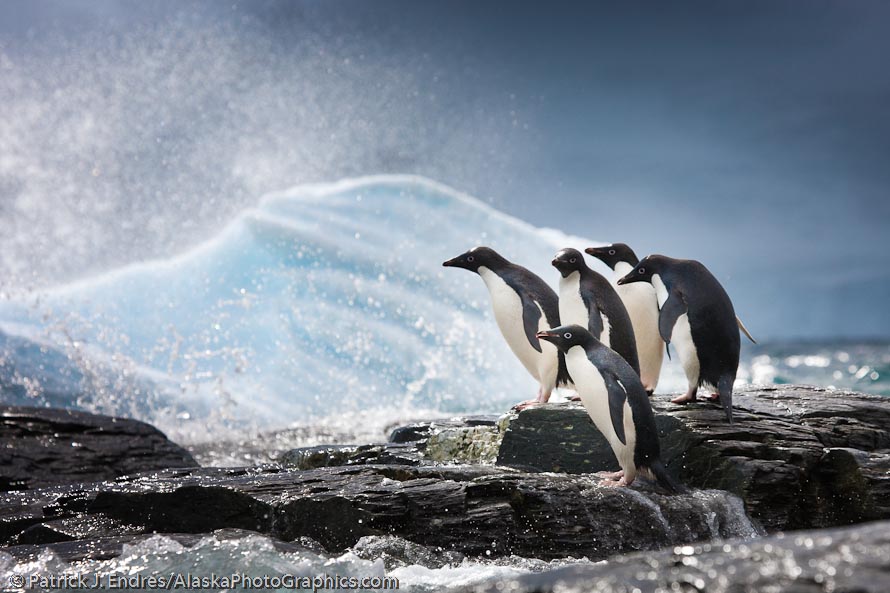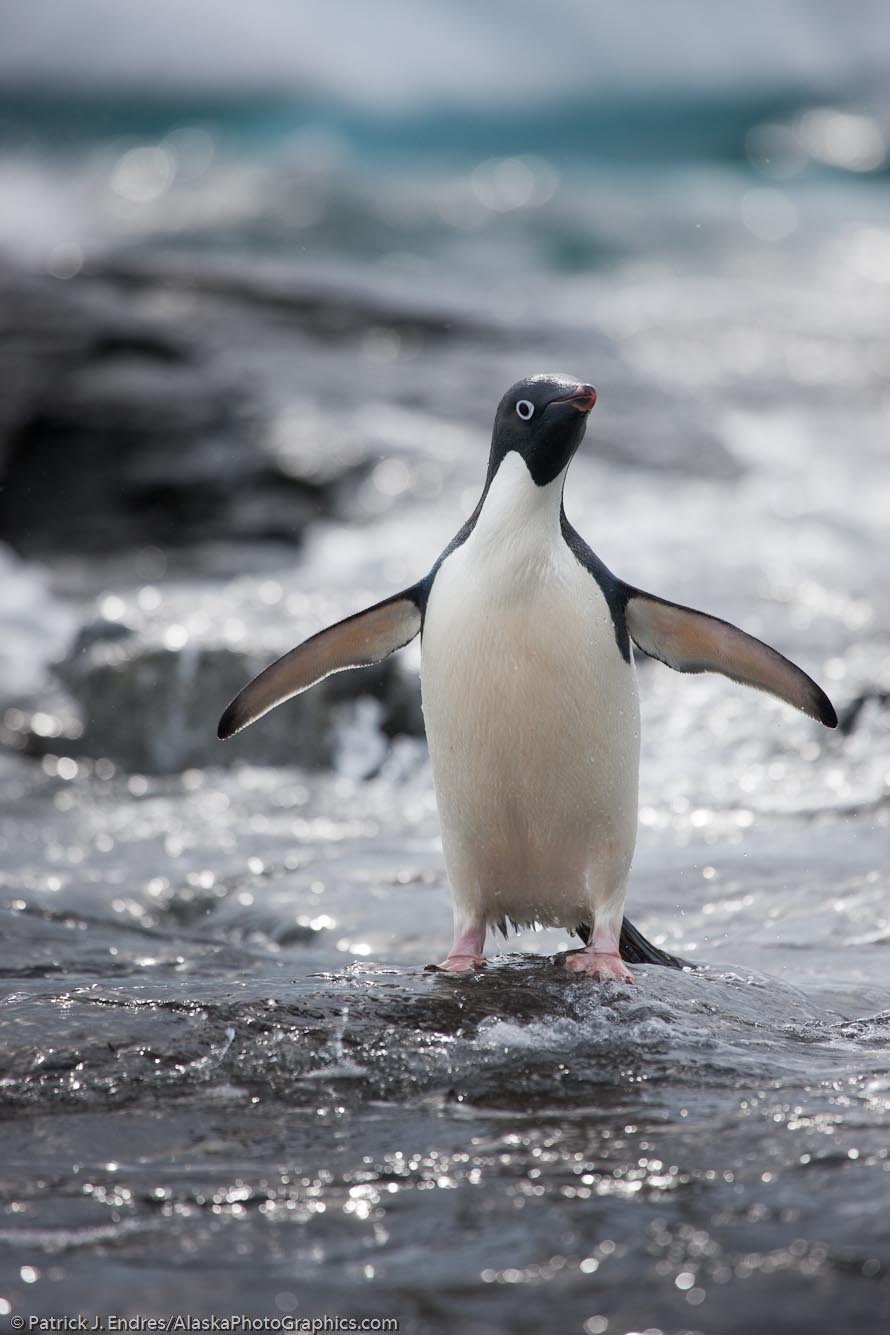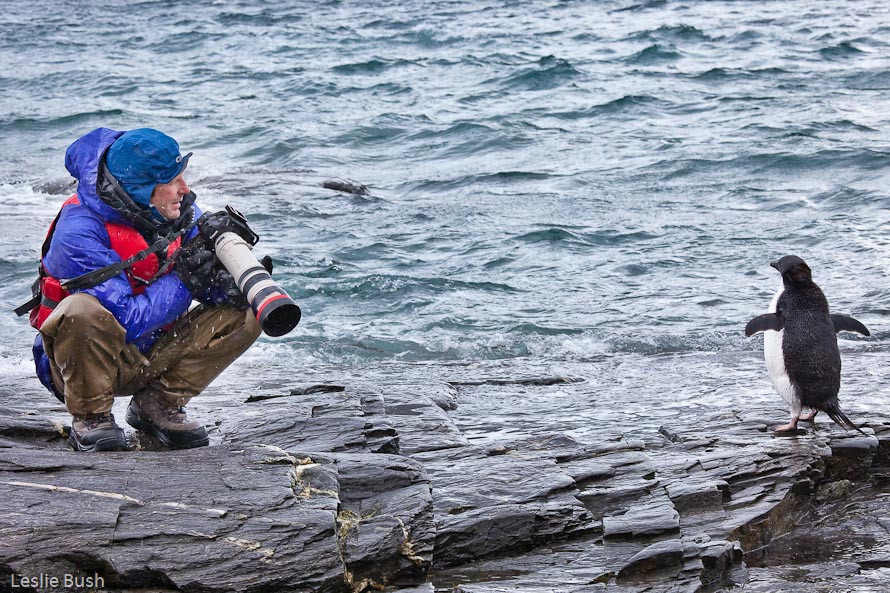
Adelie penguins, Shingle Cove, Coronation Island, South Orkney Islands. Canon 1Ds Mark III, 100-400mm 5.6L IS, (250mm), 1/800 sec @ f/9, ISO 400. All the wave splash is wind generated, the fetch in the area was rather restricted.
I wrote previously about the South Orkney Islands, which lie between South Georgia Island and the Antarctic Peninsula. The dreamy, iceberg-filled, early morning seascapes gave way to the ship’s anchorage near an Adelie penguin colony, the first of many encounters with this lively and cartoon-like little bird. The weather, ah yes, the weather…it changes quickly near the southernmost continent. One is wise who keeps vigilant eyes towards the surrounding skies. Increased winds gave cause for speculation about beach access. But a shrewd, but not altogether conflict-free decision process finally resulted in putting us all on shore. After threading zodiacs through icebergs and splashing waves, getting all ashore and tendering the skiffs for a falling tide, I was free for some photography. It turned out to be about an hour, and what an hour that was. Foreboding gray clouds and strong winds mixed with rain and hints of snow, occasionally gave way to a splash of light.

Adelie penguins, Shingle Cove, Coronation Island, South Orkney Islands. Canon 1Ds Mark II, 100-400 f/5.6L IS (400mm), 1/800 sec @ f/6.3, ISO 400. Penguin come-and-go traffic is constant near a colony, as the adults go to and from the nests with food to feed the chicks. Keep in mind that they too are food for some sea creatures, which makes their entrance and exit at the ocean's edge somewhat apprehensive and chaotic.
Between the thrill of watching penguins, monitoring weather, and trying to secure some creative images, my hour was one of quick absorption until the radio call came that our visit was cut short due to increasing winds. I scrambled back to the zodiacs, threw the wet camera gear in a dry bag and proceeded to transport passengers back to the ship. I remember very distinctly–as I neared the Polar Star gangway–watching the surface water turn whip-cream-white as a huge wind gust, which I’m guessing to be 60 knots plus, blasted off the surrounding mountain hillsides. Winds like that can flip an empty zodiac, so we always have someone on board as extra weight in the bow–that would be the ballast man. With everyone safely back on the ship, we pulled anchor and headed for the Antarctic Peninsula. Wow! It was before noon and I had two epic photographic encounters already.

- Me and the Adleie penguin. Thanks to Leslie Bush, on of the travelers for sharing this picture. This penguin came so close I could no longer focus.
I was soaking wet from dealing with skiffs, and this state was a regular daily affair. Which leads me to comment about the Canon 1Ds camera and its weatherability. I don’t consider myself kind to camera gear, and Antarctica will put not only your camera gear to the test, but also all of your clothing choices as well. I didn’t hesitate to grab my camera with my soaking wet saltwater gloves, while it was raining, and shoot away. I used a rain cover only once during the whole month, and that was for the lens, not the camera body. In all my years, the 1Ds series camera has never failed due to wet, cold or hot conditions. Like Michael Riechman of Luminous Landscape once said, “if a rhino is charging, grab the 1Ds.”
I shot with the 100-400 and 24-105 at this beach. For sheer versatility, regardless of its many less-than-flattering reviews (which I’ve made myself) the 100-400 proved invaluable. Yes, it is true, it is like a trombone with its push-pull focal-length operation, but I put it to the test while languishing right at the waters edge, in a variety of contorted positions, trying to get a good angle. The lens is relatively light weight for its range allowing for easy and stable handling in situations like this. The images are sufficiently sharp and the focal length flexibility gave me far more than I feel I lost in respect to image quality found in a prime lens. My office image quality control, which includes digital specialist Andrew Johnson, has a pretty tight quality sift, and these images will print beautifully at 20 x 30 inches, without a problem. Both the 5D Mark II and the 1Ds full sensor blow away my old film stuff. Three cheers for digital, or that would be 50 cheers in the company of my office banter.
I did shoot some video with the 5D Mark II. In this frame I used an external mic and what is called a dead kitten (a furry sound proofing sock that fits over the mic to knock wind noise down). Here is a clip:
Adelie Penguin at Shingle Cove, South Orkney Islands. Canon 5D Mark II, 24-105mm f/4L IS.






